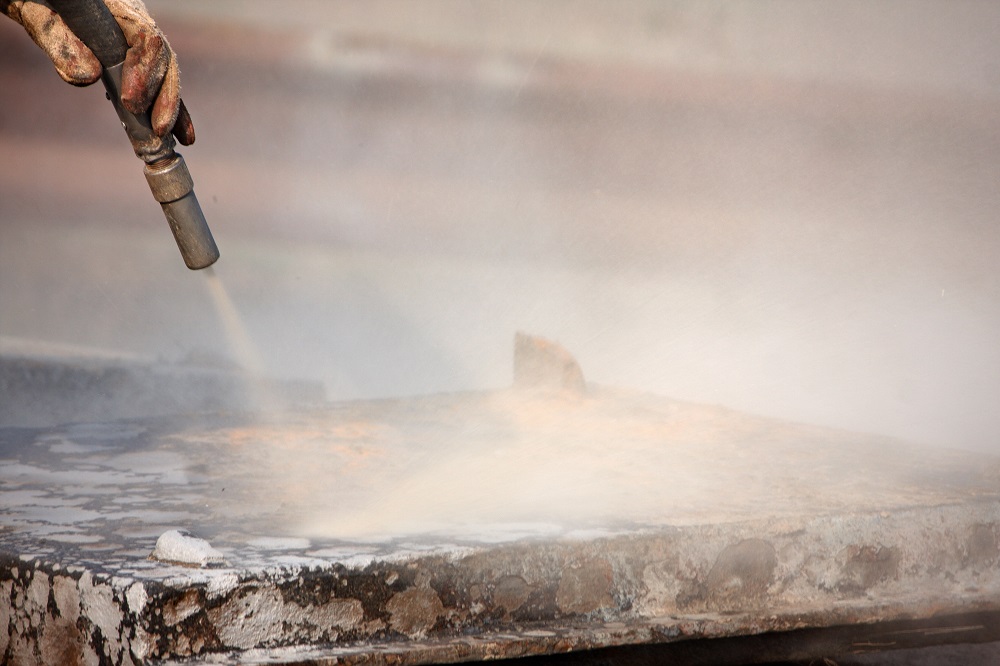Sandblasting, also known as abrasive blasting, is a commonly used technique to remove paint, and clean and prepare ship hulls, bulkheads, decks and tanks for paints and coatings during the repair and refurbishing process. Sandblasting produces dust-like particles called respirable crystalline silica, which can become airborne and be inhaled by workers.

This is a real problem, since crystalline silica is classified as a human lung carcinogen. Inhalation can result in serious, even fatal, health problems such as lung cancer, chronic obstructive pulmonary disease (COPD) and kidney disease. One of the most common and dangerous conditions caused by inhalation of crystalline silica dust is a disease called silicosis.
In response to these hazards, the U.S. Department of Labor Occupational Safety and Health Administration (OSHA) recently issued new safety standards that, among other things, establish a Permissible Exposure Limit, or PEL — the maximum amount of crystalline silica to which workers may be exposed during an 8-hour work shift — to protect workers from the dangers of respirable crystalline silica.
What is Silicosis?
Crystalline silica is found almost everywhere on Earth; it’s a basic component of soil, sand and rocks. Quartz, cristobalite and tridymite are some of the most common forms of crystalline silica. When used for sandblasting a vessel, it’s possible for all three of these substances to become reduced to respirable-sized particles that can easily be inhaled by workers.
Symptoms of silicosis include fatigue, shortness of breath, weight loss, chest pain and respiratory failure. It is usually diagnosed through a chest X-ray. There are three classifications of silicosis: chronic, the most common, results from low to moderate exposure to crystalline silica dust; accelerated, which occurs after 5 – 10 years of high exposure; and acute, which can occur as little as a few months after exposure to high concentrations of crystalline silica dust and can lead to death.
OSHA Guidelines to Limit Workers’ Exposure to Respirable Crystalline Silica Dust
OSHA’s Respirable Crystalline Silica standards require employers to protect workers from respirable crystalline silica exposures above the permissible exposure limit (PEL) of 50 µg/m3, averaged over an 8-hour day. This includes:
Have You Been Harmed as a Result of Exposure to Respirable Crystalline Silica Dust?
Are you a shipyard worker who has developed silicosis or some other serious medical condition as a result of exposure to respirable crystalline silica dust? The Jones Act and other maritime laws allow injured maritime workers to seek compensation for the damages they suffers as a result of unsafe working conditions. Lambert Zainey is here to help.
Pursuing a maritime injury claim is always a challenge, especially in a case involving silicosis, where exposure may have taken place many years previous. You need a law firm with the know-how and resources to thoroughly investigate your claim and uncover the evidence that will be needed to prove your claim.
Lambert Zainey has been successfully representing injured maritime workers and their families for over 40 years. We’ve helped thousands of injured maritime and offshore workers – from shipyard workers and dock hands to seamen and rig workers – obtain the justice they deserve for their injuries.
If you are suffering from silicosis or any other medical condition caused by exposure to harmful materials, contact the Lambert Firm to schedule a free consultation meeting to discuss your case with one of our experienced maritime injury attorneys.
